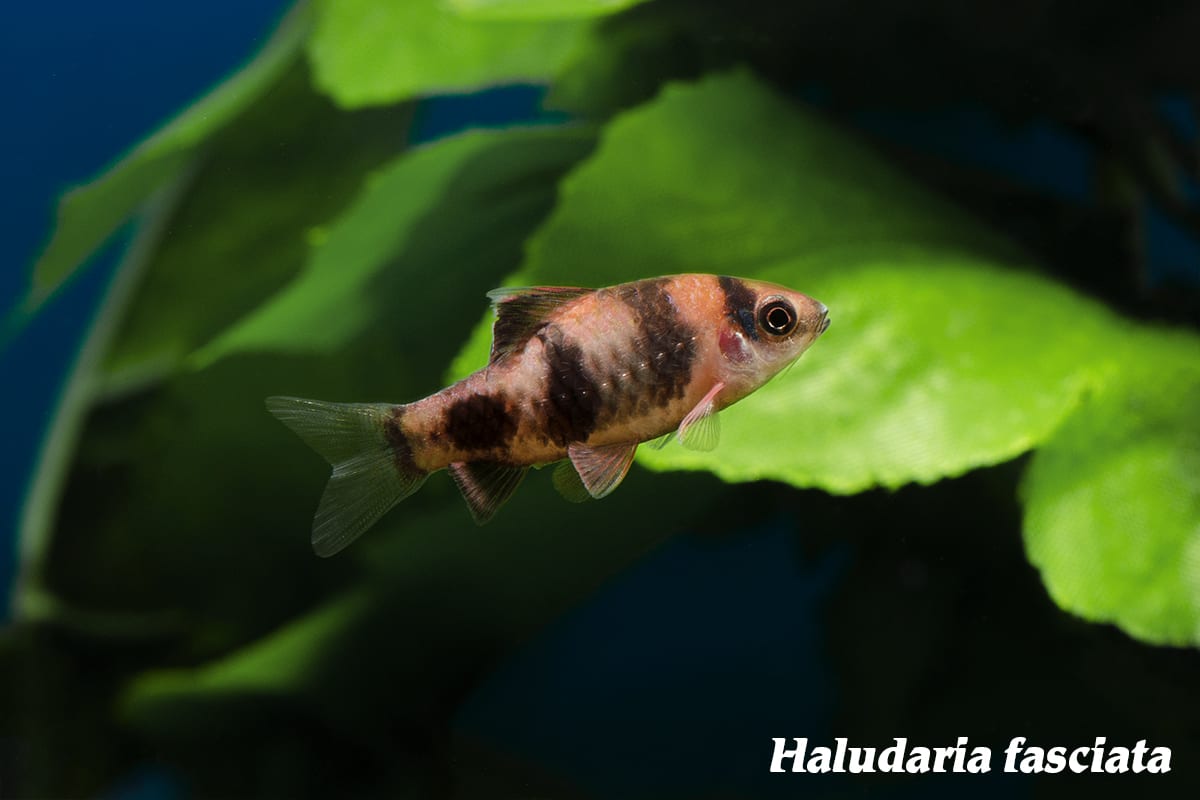Break into Barbs!
Break into Barbs!
Share on facebook
Share on twitter
Share on reddit
Share on pinterest
What is a barb? A sharp, pointed projection, or a non-phylogenetic grouping of fork-tailed, energetic, and easy-to-care-for cyprinids? Let’s take it (the word) back, and stick to the latter. Found in a wide range of sizes, in a wide-range of habitats, spanning a wide geographic range, we know better than anyone, that it can be a daunting task to break into barbs. So, let’s dip our toes, and start small in India and Bangladesh! Just a few of our favorite barbeled companions include Pethia narayani, Pethia gelius, and Haludaria fasciata.
Scientific NamePethia narayani
Common NameNarayan’s Barb
Temperature / pH68 to 78°F / 6.0 to 7.5 pH
Native LocationSouthern India
Preferred DietSmall invertebrates
Found in hill streams and small rivers along the western coast of India, P. narayani is a peaceful barb ideal for regional community tanks. “Narayan’s Barbs” reach 2.5 inches in length, and exhibit the typical pointed heads and forked tails of their congeners, silver bodies, a dark spot behind their nape, another dark spot on their caudal fin, and a red dorsal fin. Peaceful and gregarious, these barbs should be kept in conspecific groups of at least 8, and can be housed alongside other cyprinids, characins, livebearers, rainbowfish, and catfish. Naturally inhabiting low light environments, they do best in well-furnished setups with live plants, rock piles, wood, and a substrate of sand or gravel. A healthy diet for this species would consist of small invertebrates, frozen foods and high-quality tropical flake. Waters should be maintained with temperatures between 68 and 78°F, a pH of 6.0 to 7.5, and hardness around 90 to 268 ppm.
Scientific NamePethia gelius
Common NameGold Clown Barb
Temperature / pH65 to 75°F / 6.0 to 7.0 pH
Native LocationSouthern India
Preferred DietSmall invertebrates
A golden flitter, P. gelius “pops” against the sluggish, turbid, muddy marginal zones of the Brahmaputra River drainages. Known as “Gold Clown Barbs”, they reach just 1.5 inches in length with golden bodies, yellow fins, and dark bands near their dorsal and caudal fins. Found in areas with low, dappled lighting, these barbs are best kept in aquaria with dense vegetation including floating plants, driftwood roots and branches, and rocks. Though these golden cyprinids are peaceful, they’re not quite suitable for general community aquaria due to their timid natures and vulnerable size. A schooling species, they should be kept in groups of 8 or more, and can be kept with tankmates like small danios, rasboras, and shrimp. Feeding almost exclusively on small invertebrates in the wild, they should be fed regular live and frozen meals and small, dried foods. Tank waters are best kept with temperatures of 65 to 75°F, pH around 6.0 to 7.0, and hardness between 18 and 179 ppm.
Scientific NameHaludaria fasciata
Common NameMelon Barb
Temperature / pH71 to 78°F / 6.0 to 7.5 pH
Native LocationSouthern India
Preferred DietDiatoms, small invertebrates
A mountain-dweller just like their namesake, H. fasciata or “Melon Barbs” are found in streams, rivers, irrigation channels, ponds, ditches, and just about any freshwater formation in the Western Ghats mountains of southern India. Incredibly hardy and boisterous, Panda Barbs reach 2.75 inches in length and exhibit pink bodies with black markings. Undemanding with regards to tank setup, they seem to do and look best with dark substrate, lots of plants, floating plants, wood, and scattered, variable-sized, water-worn rocks. Ideal for community tanks, they can be kept alongside any peaceful species that isn’t outcompeted or spooked by their boisterous temperament. These fish are ideally kept in conspecific groups of 8 or more alongside rasboras, loaches, rainbowfish, and anabantoids. Omnivorous foragers, they consume diatoms, algae, and small invertebrates, and should be fed varied diets with live and frozen components. Tanks should be maintained with temperatures around 71 to 78°F, pH between 6.0 and 7.5, and hardness of 36 to 179 ppm.
Would you believe that when she started as a young fish associate at The Wet Spot, our author was apprehensive to catch “Barbs” for fear of getting poked? Embarrassing, but a nice reminder to learn more and look closer!


